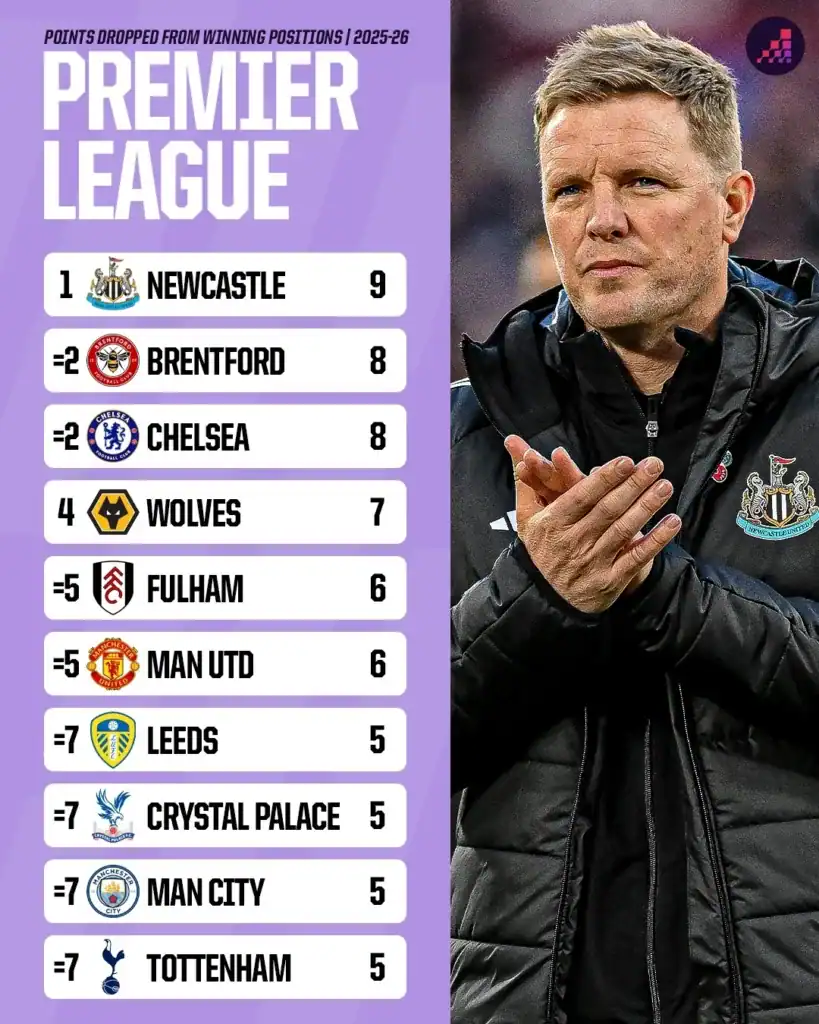Behind every Premier League result lies a hidden narrative that traditional league tables cannot capture. While final scores determine points and positions, the journey through those 90 minutes reveals far more about a team’s true character, tactical identity, and championship credentials. Game state statistics—measuring how long teams spend winning, losing, or drawing—expose the uncomfortable truths that highlights packages often conceal.

After 11 matches in the 2025-26 Premier League season, the data paints a fascinating picture that challenges conventional wisdom about who’s really dominating English football. Manchester City’s supremacy extends beyond points totals into temporal control, while defending champions Liverpool’s struggles manifest in ways that should alarm supporters at Anfield. Meanwhile, Crystal Palace has quietly assembled one of the most resilient defensive records across Europe’s elite leagues.
Table of Contents
Manchester City’s Temporal Domination
Manchester City have not merely been winning matches—they’ve been controlling game states with ruthless efficiency. Pep Guardiola’s side has spent 55.4% of their total game time leading opponents, translating to 610 minutes and 47 seconds spent ahead. This represents the only Premier League team to hold advantages for more than half of their playing time, establishing a benchmark that speaks to both clinical finishing and robust game management.
Premier League Teams Spending Most Time Winning (2025-26)
| Rank | Team | Time Ahead (%) | Time Ahead (Minutes) | League Position |
|---|---|---|---|---|
| 1 | Manchester City | 55.4% | 610:47 | 1st |
| 2 | Manchester United | 44.7% | 496:05 | 8th |
| 3 | Arsenal | 44.3% | 496:23 | 2nd |
| 4 | Bournemouth | 39.5% | Not specified | 6th |
| 5 | Chelsea | 38.2% | Not specified | 3rd |
| 6 | Brentford | 37.9% | Not specified | 12th |
Manchester City’s ability to establish early leads and maintain them reflects the tactical maturity that has defined their dynasty under Guardiola. The Citizens’ dominance in this metric correlates perfectly with their position atop the Premier League table, suggesting that controlling game states remains the most reliable predictor of sustained success.
Arsenal follows City’s blueprint closely, spending 44.3% of their matches ahead—496 minutes and 23 seconds to be precise. The Gunners have led for 18 seconds longer than Manchester United in absolute terms, though the Red Devils edge them in percentage terms due to having played slightly less football overall. This marginal difference highlights how tightly contested the race for Premier League supremacy has become.
Manchester United’s Paradox: Leading Without Winning
The most surprising revelation from game state analysis concerns Manchester United’s position as the second-highest team for time spent ahead. Ruben Amorim’s men have been winning for 44.7% of their game time (496 minutes, 5 seconds), yet this hasn’t translated into the results their superiority suggests it should.

The explanation lies in United’s alarming inability to protect leads. They’ve dropped six points from winning positions, transforming potential victories into frustrating draws or devastating defeats. This inability to close out matches represents the difference between challenging for titles and languishing in mid-table mediocrity.
Perhaps most remarkably, after just 11 games Manchester United have already been ahead for 140 minutes and 25 seconds longer than they led across their entire 27 matches under Amorim last season (355 minutes, 40 seconds). They’re only 53 minutes and 32 seconds away from surpassing their entire 2024-25 total (549 minutes, 37 seconds). This dramatic improvement in establishing advantages makes their failure to convert them into points all the more frustrating.
What’s Going Wrong?
The answer likely combines tactical naivety in defensive transitions, psychological fragility when protecting narrow leads, and potentially inadequate fitness levels that see concentration wane in crucial final minutes. For Amorim, solving this puzzle represents the difference between merely improving Manchester United and genuinely returning them to elite status.
Liverpool’s Shocking Vulnerability
If Manchester United’s game state statistics reveal unfulfilled potential, Liverpool’s numbers expose genuine crisis. The defending champions have spent a staggering 36.9% of their game time trailing opponents—413 minutes and 4 seconds spent chasing matches. Only West Ham (47%) and Wolverhampton Wanderers (57.8%) have been losing for greater percentages of their matches.
Premier League Teams Spending Most Time Losing (2025-26)
| Rank | Team | Time Behind (%) | Time Behind (Minutes) | League Position |
|---|---|---|---|---|
| 1 | Wolves | 57.8% | Not specified | 20th |
| 2 | West Ham | 47.0% | Not specified | 15th |
| 3 | Liverpool | 36.9% | 413:04 | 8th |
| 4 | Burnley | 36.4% | Not specified | 17th |
| 5 | Brighton | 34.7% | Not specified | 11th |
| 6 | Tottenham | 32.4% | Not specified | 9th |
This represents a catastrophic decline for Liverpool, who were only behind for 615 minutes and 1 second across the entirety of last season. They’re already three-quarters of the way to matching that full-season total just 11 games into the current campaign. Most alarmingly, Liverpool have been behind for 143 minutes and 29 seconds longer than they’ve been winning—a negative differential that simply cannot sustain any title challenge.
The contrast with last season, when Liverpool led for 45.6% of their game time on their way to the Premier League crown, could not be starker. Arne Slot’s side currently sits in eighth place after losing five matches, their lowest position at this stage in over a decade.
The quality within Liverpool’s squad suggests this cannot persist indefinitely, but the data reveals structural problems beyond mere bad luck. They’re one of only three teams—alongside Brighton and Newcastle—to have conceded as many goals when level (8) as they’ve scored (8), indicating significant defensive vulnerabilities that opponents are ruthlessly exploiting.
Crystal Palace: Europe’s Defensive Fortress
While headlines focus on traditional powerhouses, Crystal Palace has quietly assembled one of football’s most impressive defensive records. Oliver Glasner’s side has been behind for just 12.9% of their match time—143 minutes and 13 seconds—the shortest duration of any Premier League team.
Only 11 teams across Europe’s top five leagues have been losing for lower proportions of their matches than Palace in 2025-26, placing them in elite company alongside defensive juggernauts from Serie A, La Liga, and the Bundesliga. This represents dramatic improvement from last season’s 25.8% (10th lowest in the Premier League).
Crystal Palace’s Resilience in Numbers:
- Trailed in only 3 of 11 matches
- Behind for 10 minutes at Everton
- Behind for 60 minutes and 45 seconds at Arsenal
- Behind for 72 minutes and 28 seconds at home to Bournemouth
This defensive solidity explains why Palace was widely tipped for relegation during pre-season yet has emerged as one of the league’s toughest opponents. Glasner has constructed a team that makes life miserable for opponents, rarely gifting early advantages and consistently finding ways to stay competitive throughout matches.
Chelsea follows Palace’s example, trailing for only 13.1% of their match time (146 minutes, 21 seconds). Remarkably, 93 and a half minutes of that deficit came in their 2-1 defeat at Manchester United, where they were reduced to 10 men after just five minutes. Excluding that anomalous result, Enzo Maresca’s side has been behind for just 52 minutes and 51 seconds—testament to their consistency despite perceptions of unpredictability.
Newcastle’s Troubling Pattern
Newcastle United’s game state statistics reveal a team caught in frustrating patterns. Despite sitting 14th after losing at Brentford, only four teams have been behind for shorter percentages of their game time than the Magpies (17.8%). This paradox—competitive in matches yet accumulating disappointing points tallies—stems from one glaring weakness.

No Premier League team has dropped as many points from winning positions as Newcastle’s nine. Their two devastating late losses at home to Liverpool and Arsenal partially explain the deficit between game state dominance and actual results, but the pattern suggests deeper issues with game management and mental resilience.
Newcastle has also played more Premier League minutes than any other team this season (1,125 minutes, 15 seconds), meaning their struggles cannot be attributed to fixture congestion or fatigue. They’re also the only club that hasn’t been more than two goals ahead or behind, indicating matches remain perpetually close and psychologically demanding.
The Drawing Game: Sunderland’s Stalemate Specialists
While winning generates points and losing costs them, drawing represents football’s ultimate state of uncertainty. Some teams thrive in these knife-edge scenarios; others wilt under the pressure of needing to force breakthrough moments.
Sunderland has been drawing for longer than any other Premier League team—59.3% of their match time, translating to nearly 11 hours (657 minutes, 44 seconds) caught in stalemates. For a newly-promoted side that many predicted would suffer immediate relegation, this resilience represents a remarkable achievement.
Premier League Teams Spending Most Time Drawing (2025-26)
| Rank | Team | Time Drawing (%) | Time Drawing (Minutes) | Draws This Season |
|---|---|---|---|---|
| 1 | Sunderland | 59.3% | 657:44 | Multiple |
| 2 | Newcastle | 57.7% | Not specified | Multiple |
| 3 | Crystal Palace | 56.2% | Not specified | 5 (most in league) |
| 4 | Fulham | 52.1% | Not specified | Multiple |
| 5 | Nottingham Forest | 52.0% | Not specified | Multiple |
Coupled with having been behind for only 20.9% of their games (sixth-smallest percentage in the Premier League), Sunderland’s defensive organization under Regis Le Bris has proven exceptionally difficult to break down. They’ve also won nine points from losing positions—more than any other team—demonstrating remarkable character when facing adversity.
Newcastle follows closely with 57.7% of their time spent level, setting up an intriguing Tyne-Wear derby when they meet at the Stadium of Light on December 14. Crystal Palace’s 56.2% aligns with their league-leading five draws, while Fulham (52.1%) and Nottingham Forest (52.0%) round out the top five.
At the opposite end, Brentford rarely experiences stalemates, drawing for just 29.9% of their overall match time. The Bees’ approach emphasizes decisive action—they’re either ahead (37.2%) or behind (32.1%), with level scorelines representing their rarest state. This aggressive tactical philosophy under Thomas Frank produces entertainment even when results prove inconsistent.
What Game States Reveal About Title Races
Game state statistics provide predictive power beyond traditional metrics. Teams that spend significant time ahead typically possess the tactical discipline and squad depth necessary for sustained success. Manchester City’s 55.4% illustrates why they remain favorites despite Arsenal’s challenge, while Liverpool’s alarming 36.9% time spent behind suggests their title defense has already effectively ended.
The Manchester United paradox—second-highest for time ahead yet eighth in the table—demonstrates that establishing advantages means nothing without the killer instinct to preserve them. Their six dropped points from winning positions could easily be twelve with slightly better game management, potentially placing them in genuine title contention rather than mid-table anonymity.

For teams battling relegation, game state analysis offers both hope and warning. Crystal Palace’s defensive solidity (12.9% time behind) suggests they’ll comfortably avoid the drop, while Wolves’ league-worst 57.8% time spent losing indicates serious danger unless dramatic improvements materialize quickly.
As the Premier League season progresses toward the 19-game midpoint where all teams will have faced every opponent once, these patterns will either solidify into defining characteristics or prove temporary aberrations. What remains clear is that controlling game states—not merely moments—separates championship contenders from pretenders in English football’s most demanding competition.
FAQs
Which Premier League team has spent the most time winning this season?
Manchester City has spent 55.4% of their game time ahead (610 minutes, 47 seconds), the only Premier League team to lead for more than half of their total playing time in 2025-26.
Why is Liverpool struggling with game states in 2025-26?
Liverpool has been behind for 36.9% of their matches (413 minutes), spending 143 minutes longer losing than winning. This represents three-quarters of their entire 2024-25 total despite playing just 11 games, indicating serious defensive vulnerabilities.
How has Manchester United improved under Ruben Amorim?
Manchester United has been ahead for 44.7% of their game time—already 140 minutes longer than their entire 27-match total under Amorim last season. However, they’ve dropped six points from winning positions, indicating problems closing out matches.
Which Premier League team is hardest to beat in 2025-26?
Crystal Palace has been behind for just 12.9% of their match time (143 minutes), the lowest in the Premier League and among the 12 best defensive records across Europe’s top five leagues.
What does time spent drawing indicate about Premier League teams?
Sunderland has been drawing for 59.3% of their matches (657 minutes), showing defensive resilience for a promoted side. Newcastle (57.7%) and Crystal Palace (56.2%) also spend significant time level, indicating tactical caution and defensive organization.








